 Our first visit this Wednesday is the Villa Farnesina in Trastevere.
Our first visit this Wednesday is the Villa Farnesina in Trastevere.On our way to the bus stop on the Via Mamorata we pass, as usual, the Piramide di Caio Cestio and the Porta San Paolo.



It's the pseudonym of Carlo Alberto Salustri, born in Rome in 1871. His mother was from Bologna and his father, a waiter, from Albano Laziale. His childhood was filled with mourning and sadness, but he was perhaps too small to feel the full brunt of it. He lost his younger sister Elisabetta at the age of two and his father at the age of three. His mother was a seamstress and somewhat stern with the child, who was a poor and listless student. At sixteen he dropped out of school, but had already written his first verses.
In 1887 one of his poems came out in Il Rugantino, edited by Gigi Zanazzo, along with a prose piece signed with the pseudonym Marco Pepe. He became soon popular for a series of portraits of Roman girls he published in 1889 under the title Stelle de Roma [Roman Stars]. Immediately a dispute broke out with the Roman dialect poet Filippo Chiappini, who accused Trilussa of not knowing the dialect, taking the position of the "vernacular purist," as Claudio Rendina calls him.
The poet's popularity was almost immediate, his contributions to Il Messaggero were followed and discussed; even his drawings were well received by the mass of readers. He worked on the editorial staff of Don Chisciotte, providing images, sketches, fables, skits, vignettes and poems with that easy vein that would become a distinctive trait of his life and work.
In 1887 one of his poems came out in Il Rugantino, edited by Gigi Zanazzo, along with a prose piece signed with the pseudonym Marco Pepe. He became soon popular for a series of portraits of Roman girls he published in 1889 under the title Stelle de Roma [Roman Stars]. Immediately a dispute broke out with the Roman dialect poet Filippo Chiappini, who accused Trilussa of not knowing the dialect, taking the position of the "vernacular purist," as Claudio Rendina calls him.
The poet's popularity was almost immediate, his contributions to Il Messaggero were followed and discussed; even his drawings were well received by the mass of readers. He worked on the editorial staff of Don Chisciotte, providing images, sketches, fables, skits, vignettes and poems with that easy vein that would become a distinctive trait of his life and work.
Inscription: Mentre me leggo er solito giornale sparacchiato all ombra d'vn parajo vedo vn porco e je dico - addio majalei - vedo vn civccio e je dico - addio, somaroi-
Forse 'ste bestie nvn me capiranno, ma provo armeno la soddisfazione de pote di le cose come stanno senza pavra de fini in priggione.
We walk through the Ghetto to the Villa Farnesina, in the Via della Lungara
 The villa was built for Agostino
Chigi, a rich banker and the treasurer of Pope Julius II between 1506–1510. The
villa, intended to be an airy summer pavilion, presented a side towards the
street and was given a U shaped plan with a five bay loggia between the arms.
The villa was built for Agostino
Chigi, a rich banker and the treasurer of Pope Julius II between 1506–1510. The
villa, intended to be an airy summer pavilion, presented a side towards the
street and was given a U shaped plan with a five bay loggia between the arms. In the original arrangement, the main entrance was through the north facing loggia which was open.

Chigi also commissioned the fresco decoration of the villa by artists such as Raphael, Sebastiano del Piombo, Giulio Romano an Il Sodoma.
 |
| "Triumph of Galatea" (showing the near-naked nymph on a shell-shaped chariot, reminiscent of Botticelli’s The Birth of Venus. |
The Loggia of Galatea was frescoed by different artists. Raphael frescoed the
Triumph of Galatea, Baldassarre Peruzzi in 1511 frescoed the vault with a mythological and astrological programme, alluding to the horoscope of Agostino Chigi, and in 1511‐1512 Sebastiano del Piombo frescoed the mythological scenes in the lunettes and the Polyphemus. The other panels have landscapes painted in the seventeenth century.
Triumph of Galatea, Baldassarre Peruzzi in 1511 frescoed the vault with a mythological and astrological programme, alluding to the horoscope of Agostino Chigi, and in 1511‐1512 Sebastiano del Piombo frescoed the mythological scenes in the lunettes and the Polyphemus. The other panels have landscapes painted in the seventeenth century.




THE LOGGIA OF CUPID AND PSYCHEThe Loggia takes its name from the decoration frescoed on the vault in 1518 by
Raphael and his workshop, representing episodes from the fable of Psyche as narrated in Apuleius’s “Golden Ass”. The story, separated by festoons of flowers and fruits by Giovanni da Udine, fills the spandrels and concludes in the centre with the Marriage of Cupid and Psyche and the Council of the Gods.




At first floor level, Peruzzi painted the main salone with trompe-l’oeil frescoes of a painted grand open loggia with city and countryside views beyond.
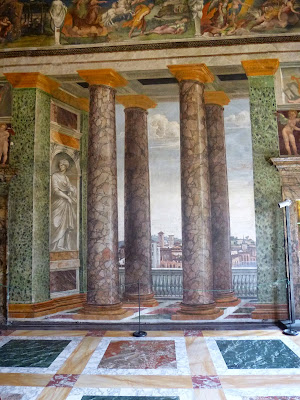


In the adjoining bedroom, Sodoma painted scenes from the life of Alexander the Great , the marriage of Alexander and Roxana, and Alexander receives the family of Darius.
Later the villa belonged to the Bourbons of Naples, and in 1861 to the Spanish Ambassador in Rome.
 We continue our walk through the Ghetto (through the gate of the Via Lungara)
We continue our walk through the Ghetto (through the gate of the Via Lungara)
Basilica Santa Maria della Scala
It was sited adjacent to a monastery
famous for containing the Papal court's 17th century pharmacy.
In 1849, during the last stages of the
revolutionary Roman Republic’s resistance to the invading French forces, Santa
Maria della Scala was used as a hospital where Garibaldi’s soldiers, wounded in
the Trastevere fighting, were treated.










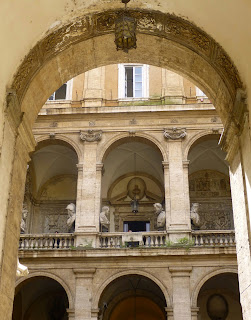

The theatre of Marcellus was completed
in the late 1st century BCE during the reign of Augustus. The architecture of
the theatre would become a standard feature of theatres across the empire, and
influence the façades of such iconic buildings as the Coliseum.
The building project was actually begun by Julius Caesar but not completed until the reign of Augustus. In 13 BCE the emperor dedicated the theatre to his nephew Marcus Claudius Marcellus - son of Octavia and his daughter Julia’s husband - who had been his heir prior to his early death in 23 BCE. To make room for the theatre within the Forum Holitorium the ancient Flaminian Circus was demolished and, the temple of Apollo was moved a few metres.
 |
| Palazzo Senatorio |
We arrive at the Piazza del Campidoglio (visited in the dark on my first evening), one of Rome's most beautiful squares, designed in the sixteenth century by Michelangelo and laid out between two summits of the Capitoline Hill, the most important of Rome's fabled seven hills.
Piazza del Campidoglio is bordered on three sides by elegant buildings.
The central one sporting a clock tower is Palazzo Senatorio. To the right is the Palazzo dei Conservatori and to the left its mirror image, Palazzo Nuovo.


Finally, Michelangelo's ambitious plans for the square also included the creation of an elegant staircase, the Cordonata.
 In the center of the square stands
In the center of the square stands an equestrian statue of
the Roman Emperor Marcus Aurelius. The statue is a replica; the original was replaced in 1981 and moved to the Capitoline Museums to protect it from the elements.
The bronze gilded statue only survived because it was thought to depict Emperor Constantine, the first Christian emperor.
This church is the only one on the
Capitoline Hill, which the ancient Romans regarded as being the location of the
first settlement in their future city.
In ancient days, the access to the
summit was not by the staircase and ramp there now from the Piazza Aracoeli.
There was a carriage road, the Clivus Capitolinus which started at the
Arch of Septimus Severus, tracked up the side of the hill past the Temple of
Saturn and turned sharply right to end in front of the Temple of Jupiter.
We enter through the old back entrance.






 |
| San Antonio di Padova |
 |
| Capella di S. Bernardino da Siena |

The Monument to Victor Emanuel II, also known as 'Il Vittoriano' and sometimes also referred to as the Altare della Patria (Altar of the Nation), is a bombastic monument built with sparkling white marble from Botticino in the province of Brescia. It is decorated with numerous allegorical statues, reliefs and murals, created by artists from all corners of the country.
As King of Sardinia and victor over the Austrian army in Lombardy, Victor Emmanuel had become a symbol of the Risorgimento, the movement for a united Italy. After his army joined forces with Garibaldi and defeated the papal army, the Kingdom of Italy was proclaimed in 1861 with Victor Emmanuel as king.
The Victor Emmanuel Monument is not exactly known as one of Rome's most beautiful structures. It is considered too monumental and the bright white color does not fit well into the ochre color of its surroundings. The monument has been given nicknames such as 'typewriter' and 'wedding cake'.
The Imperial Fora (Fori Imperiali in Italian) are a series of monumental fora (public squares), constructed over a period of one and a half centuries, between 46 BC and 113 AD.
Julius Caesar was the first to build in this section of Rome and rearranged both the Forum and the Comitium, another forum type space designated for politics, to do so. These forums were the centres of politics, religion and economy in the ancient Roman Empire.
The Trajanic project was funded by the rich spoils Trajan returned to Rome from the Dacian Wars, a conflict waged in two separate campaigns over the years 101-102 and 105-106.
 Trajan’s commemorative Column is, ironically, one of the best preserved and least accessible monuments left to us from the ancient city. It has survived essentially intact, missing only its original painted decoration, the metal attachments that added detail to the sculpted figures, and of course the great bronze statue of the emperor himself that once crowned the top of the column (the statue of St. Peter was added by Pope Sixtus V in 1588).
Trajan’s commemorative Column is, ironically, one of the best preserved and least accessible monuments left to us from the ancient city. It has survived essentially intact, missing only its original painted decoration, the metal attachments that added detail to the sculpted figures, and of course the great bronze statue of the emperor himself that once crowned the top of the column (the statue of St. Peter was added by Pope Sixtus V in 1588).
The column consists of twenty-nine pieces of white marble, the largest one weighing up to seventy-seven tons. A band of beautifully carved reliefs winds around the column. The band is more than 180 meters (600ft) long.
There are more than two thousand carved figures on the column that depict the story of Trajan's Dacian war campaigns conducted between 101-102 and 105-106 AD. The width of the band varies from 60cm (2ft) at the bottom to 120cm at the top so that the carved figures would seem to have an equal height when seen from the ground.
The story starts with soldiers preparing for the war and ends with the Dacians being ousted from their homeland.

 We leave temporarily the Capitolino for our reserved vsit to "Le Domus Romane" under the Palazzo Valentini,
We leave temporarily the Capitolino for our reserved vsit to "Le Domus Romane" under the Palazzo Valentini, The multimedia museum: where antiquity meets innovation
A visit to the fascinating remains of the patrician "Domus" of imperial Rome, belonging to powerful families, with mosaics, wall decorations, polychrome floors, paving blocks, and other remains, has been further enhanced by a project curated by Piero Angela and a team of experts, including Paco Lanciano and Gaetano Capasso, who have recreated the past with virtual reconstructions, graphics and videos. Visitor can see walls, rooms, peristyles, kitchens, baths, furnishings and decorations all come back to life, taking a virtual tour of a great Domus of ancient Rome.


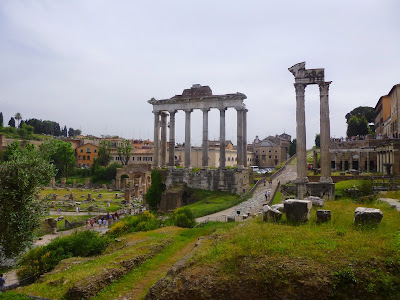


We take the "Rama del Cielo" elevator to the top of the "Vittoriano" where the view is fabulous.



 Our last visit today is to the Capitolini Musei.
Our last visit today is to the Capitolini Musei. 
 |
| The Medusa by Gian Lorenzo Bernini |
 |
| The original statue of Marcus Aurelius |
The Burial of St. Petronilla is an altarpiece painted by Giovanni Francesco Barbieri (Guercino) around 1623. It simultaneously depicts the Burial and the welcoming to heaven of the martyred St. Petronilla. The altarpiece was painted for St. Peters's Basilica, for a chapel dedicated to the saint and containing her relics but is now on display in the Capitoline Museums.
 |
| Caravaggio (Michelangelo Merisi, Milan 1571 - Porto Ercole 1610) |


























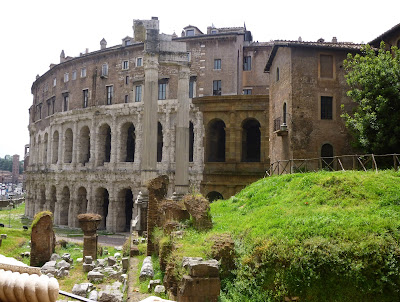

















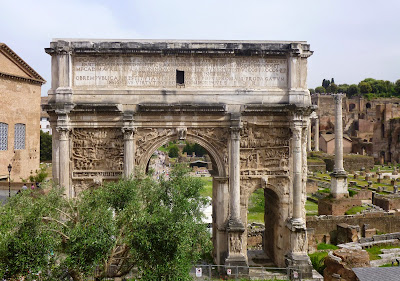






























Geen opmerkingen:
Een reactie posten